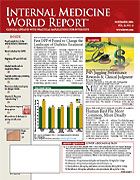Publication
Article
Internal Medicine World Report
Malpractice Alert: Diagnostic Errors Most Common Problem
Author(s):
Missed or delayed diagnoses cause considerable harm to patients treated in ambulatory care settings, conclude the authors of a retrospective review (Ann Intern Med. 2006; 145:488-496).
Diagnostic errors were cited in nearly 60% of the 307 closed medical malpractice claims reviewed; about 33% of them resulted in the patient's death.
Claim data were provided by 4 malpractice insurance companies based in 3 regions of the United States. Jointly, these companies insure approximately 21,000 physicians, 46 acute care hospitals, and 390 outpatient facilities, including a variety of primary care and outpatient specialty practices.
Investigators used the Institute of Medicine's definition of error: "The failure of a planned action to be completed as intended or the use of a wrong plan to achieve an aim."
Of the 307 cases reviewed, 181 involved errors that resulted in an adverse patient outcome, often a delayed or inaccurate diagnosis of cancer (primarily breast, colorectal, or skin cancer).
The majority of errors (85%) occurred in physicians' offices, and 42% of them involved primary care physicians. The most common diagnostic misstep was not ordering the appropriate test, followed by failure to have an appropriate follow-up plan, not conduct an adequate physical examination, or incorrectly interpret a diagnostic test.
Among the reasons for the breakdowns in the diagnostic process of the cancer patients, the investigators, led by Tejal K. Gandhi, MD, MPH, identified misinterpreted test results (46%) and incorrectly performed diagnostic tests (13%) as the most common blunders.
In contrast, missed noncancer diagnoses, such as infection, fracture, or myocardial infarction, were more often attributed to patient delay in seeking care, an inadequate patient history or physical examination, or failing to refer the patient for additional care.
"Outpatient diagnostic errors are due to multiple breakdowns in care processes and will therefore require multiple interventions to prevent," said coinvestigator Eric Thomas, MD.
"Physicians will need more computerized decision support and better methods to follow up diagnostic tests. We also need to make it easier for patients to follow through with complicated outpatient evaluations and to give them access to their medical information," Dr Thomas added.
Diagnostic tests that physicians most often failed to order were biopsies, followed by computed tomography, mammography, and colonoscopy. The most common explanation for not ordering a test was the physician not knowing that it was indicated for the condition.
A failure in judgment is pinpointed as the leading cause of diagnostic errors. Other contributing factors involved vigilance or memory, knowledge, patient-related factors, and handoffs of care.
Having >1 physician involved in a patient's care also played a role. In nearly half (43%) of the cases, ≥2 physicians contributed to the missed diagnosis, and in 16%, ≥3 physicians contributed. In addition, delays in diagnosis were often prolonged, averaging >1 year.
"These errors are complex, and most are caused by multiple breakdowns in the diagnostic process and involve multiple doctors and healthcare providers," Dr Gandhi said. "Because of this complexity, finding quick solutions will be difficult. Understanding the most common breakdowns, such as failure to order a test and failure to create a proper follow-up plan, is a first step in designing prevention strategies," he added.






